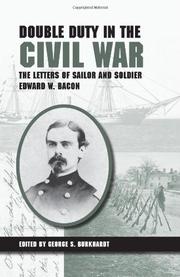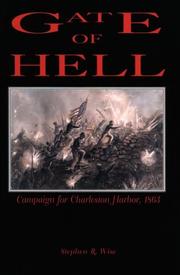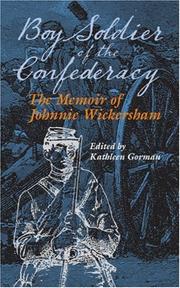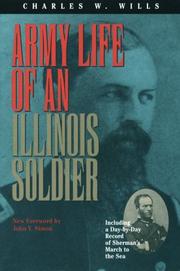| Listing 1 - 10 of 56 | << page >> |
Sort by
|
Book
ISBN: 1623494176 1623494168 9781623494162 9781623494179 Year: 2016 Publisher: College Station : Texas A&M University Press,
Abstract | Keywords | Export | Availability | Bookmark
 Loading...
Loading...Choose an application
- Reference Manager
- EndNote
- RefWorks (Direct export to RefWorks)
Mexican War, 1846-1848 --- Mexican-American War, 1846-1848 --- United States-Mexican War, 1846-1848 --- Campaigns --- Regimental histories --- United States. --- Mississippi Infantry Regiment, 2nd (1846-1848) --- Mississippi Volunteers Regiment, 2nd (1846-1848) --- Mississippi Volunteer Regiment, 2nd (1846-1848) --- Mississippi Rifles, 2nd (1846-1848) --- Mississippi Volunteer Regiment, 1st (1846-1848) --- Mississippi Infantry Regiment, 1st (1846-1848) --- Mississippi Rifles, 1st (1846-1848) --- History.
Book
ISBN: 1283693062 178151383X 9781781513835 9781283693066 Year: 2011 Publisher: Luton Andrews UK
Abstract | Keywords | Export | Availability | Bookmark
 Loading...
Loading...Choose an application
- Reference Manager
- EndNote
- RefWorks (Direct export to RefWorks)
This is the story of a regular battalion from mobilization to the end of the Battle of the Aisne in September 1914. When war broke out 1st E Lancs, a regular battalion, was stationed in Colchester, part of 11th Brigade, 4th Division. The battalion arrived in France on 22nd August 1914 and we are given the list of officers who embarked with the battalion. This account of the battalion's experiences in just three weeks includes the Battle of Le Cateau, the retreat to the Marne, the Battle of...
Book
ISBN: 1783949392 9781783949397 Year: 2014 Publisher: [London, England]
Abstract | Keywords | Export | Availability | Bookmark
 Loading...
Loading...Choose an application
- Reference Manager
- EndNote
- RefWorks (Direct export to RefWorks)
John Gallishaw was born in St Johns, Newfoundland in Canada in 1891. Educated at Harvard he was 23 when the Great War broke out. He returned home to join the Canadian army in Halifax. He was assigned to the Cyclist Corps of the Second Division, Canadian Expeditionary Force but in March, 1915, he asked for and received a discharge. On April 3 he enlisted in the First Newfoundland regiment which was about to cross the Atlantic and join up with the British army. Most soldiers in the regiment were transferred to Aldershot before being sent on to Malta. Just before dispatch he complained to an adjutant who assigned him to B company of the regiment. He took part in the evacuation of Gallipoli where he was wounded and eventually he was demobilised. He returned to Harvard as a lecturer but in 1917 with the United States entering the war he enlisted again, this time in the American army. In France he took part in several battles and became a commander of a battalion then joined the United States American Army Intelligence Service and served as a liaison officer with the British forces. After the war he continued to write as well as establish the John Gallishaw School of Creative Writing in Cambridge. He wrote for radio, theatre and television as well as in Hollywood for many of the major studios. John Gallishaw died in 1968

ISBN: 1280696982 9786613673947 0809386496 144162340X 9781441623409 9780809386499 9780809329106 0809329107 6613673943 Year: 2009 Publisher: Carbondale Southern Illinois University Press
Abstract | Keywords | Export | Availability | Bookmark
 Loading...
Loading...Choose an application
- Reference Manager
- EndNote
- RefWorks (Direct export to RefWorks)
Soldiers --- Sailors --- Bacon, Edward W. --- United States. --- Connecticut Infantry, 29th Regiment (1864-1865) --- Connecticut Volunteers, 29th Regiment (1864-1865) --- Connecticut --- United States --- Connecticutt --- State of Connecticut --- New-Haven Colony --- History --- Naval operations.

ISBN: 058533627X 9780585336275 0872499855 Year: 1994 Publisher: Columbia University of South Carolina Press
Abstract | Keywords | Export | Availability | Bookmark
 Loading...
Loading...Choose an application
- Reference Manager
- EndNote
- RefWorks (Direct export to RefWorks)
Morris Island, Battle of, S.C., 1863 (July 10-September 7) --- United States - General --- Regions & Countries - Americas --- History & Archaeology --- Fort Wagner, Battle of, S.C., 1863 (July 10-September 7) --- Morris Island (S.C.), Battle of, 1863 --- United States. --- Massachusetts Infantry, 54th Regiment (1863-1865) --- Massachusetts Colored Volunteers, 54th Regiment (1863-1865) --- Massachusetts Volunteer 54th Regiment (1863-1865) --- Massachusetts Volunteer Infantry, 54th Regiment (1863-1865) --- Fort Wagner (S.C.) --- Wagner, Fort (S.C.)

ISBN: 1280697180 9786613674142 0809387948 9780809387946 0809327228 9780809327225 9781280697180 6613674141 Year: 2006 Publisher: Carbondale Southern Illinois University Press
Abstract | Keywords | Export | Availability | Bookmark
 Loading...
Loading...Choose an application
- Reference Manager
- EndNote
- RefWorks (Direct export to RefWorks)
Johnnie Wickersham was fourteen when he ran away from his Missouri home to fight for the Confederacy. Fifty years after the war, he wrote his memoir at the request of family and friends and distributed it privately in 1915. Boy Soldier of the Confederacy: The Memoir of Johnnie Wickersham offers not only a rare look into the Civil War through the eyes of a child but also a coming-of-age story.Edited by Kathleen Gorman, the volume presents a new introduction and annotations that explain how the war was glorified over time, the harsh realities suppressed in the nation's
Child soldiers --- Soldiers --- Boys as soldiers --- Children as soldiers --- Armed Forces personnel --- Members of the Armed Forces --- Military personnel --- Military service members --- Service members --- Servicemen, Military --- Armed Forces --- Wickersham, John T., --- Wickersham, Johnnie, --- Confederate States of America. --- Missouri Infantry, 1st Regiment --- Missouri Infantry, 4th Regiment --- Bowen's Regiment --- United States --- Missouri --- Confederate States of America --- State of Missouri --- US-MO --- MO (State) --- Missouri Territory --- History --- Participation, Juvenile. --- Regimental histories. --- Drummer boys --- Juvenile participants --- Regimental histories
Book
ISBN: 128088181X 9786613723123 0809331292 9780809331291 9781280881817 9780809331284 0809331284 Year: 2012 Publisher: Carbondale Southern Illinois University Press
Abstract | Keywords | Export | Availability | Bookmark
 Loading...
Loading...Choose an application
- Reference Manager
- EndNote
- RefWorks (Direct export to RefWorks)
A classic story of a young man's journey to adulthood, The Boy of Battle Ford covers Blackman's years growing up in early post-settlement Illinois, where he gave in to temptations such as drinking, gambling, and the lure of prostitutes before joining the army, finding God and becoming a preacher. Blackman, who notes that he is determined to "write facts" in this book, peppers his story with the sordid details of the sinful times of his life as well as with discussions of faith and of struggling to understand his God and his beliefs.
Blackman, W. S. --- Blackman, William S., --- United States. --- Illinois Infantry, 120th Regiment (1862-1865) --- U.S. Army --- US Army --- Military life. --- Illinois --- United States --- History
Book
ISBN: 1940669731 9781940669731 9781611213591 1611213592 Year: 2018 Publisher: El Dorado Hills, California
Abstract | Keywords | Export | Availability | Bookmark
 Loading...
Loading...Choose an application
- Reference Manager
- EndNote
- RefWorks (Direct export to RefWorks)
"Union surgeon James Dana Benton witnessed firsthand the suffering and death brought about by the ghastly wounds, infections, and diseases that wreaked havoc to both the Union and Confederate armies. A native of New York, Dr. Benton penned a series of letters throughout the war to his family relating his experiences with the 111th New York Infantry as an assistant surgeon, and later with the 98th New York as surgeon. His unique correspondence, together with insights from author Chris Loperfido, coalesce to produce Death and Disease in the Civil War : A Union Surgeon's Correspondence from Harpers Ferry to Richmond. Dr. Benton was present for some of the war's most gruesome and important battles, including Gettysburg, Cold Harbor, and the siege of Petersburg. He was also present at Harpers Ferry, Second Battle of Auburn, Battle of Morton's Ford, and Abraham Lincoln's second Inaugural address. His pen offers an insightful and honest look into what everyday life was like for the surgeons who tirelessly worked to save the men who risked their lives for the preservation of the nation. Loperfido's Death and Disease in the Civil War should be read by every student of the Civil War to better understand and come to grips with what awaited the wounded and the medical teams once the generals were finished with their work"--Provided by publisher.
Surgeons --- Surgery, Military --- Military surgery --- Medicine, Military --- Operating room personnel --- Physicians --- History --- Benton, James D. --- Benton, J. D. --- United States. --- New York Infantry. --- New York Infantry, 111th Regiment (1862-1865) --- New York Infantry Regiment, 111th (1862-1865) --- United States --- New York (State) --- Confederate States of America --- Medical care. --- Regimental histories. --- Regimental histories --- Civilian relief

ISBN: 0585106304 9780585106304 9780809320462 0809320460 0809320460 Year: 1996 Publisher: Carbondale : Southern Illinois University Press,
Abstract | Keywords | Export | Availability | Bookmark
 Loading...
Loading...Choose an application
- Reference Manager
- EndNote
- RefWorks (Direct export to RefWorks)
Sherman's March to the Sea --- Regions & Countries - Americas --- History & Archaeology --- United States - General --- Personal narratives. --- Personal narratives --- Wills, Charles Wright, --- Wills, Charles W., --- United States. --- Illinois Infantry, 103rd Regiment (1862-1865) --- Illinois Infantry, 8th Regiment (1861-1866) --- Illinois Volunteer Infantry, 8th Regiment (1861-1865) --- 8th Illinois Infantry Regiment (1861-1866) --- 8th Illinois Volunteer Infantry (1861-1866) --- Illinois Cavalry, 7th Regiment (1861-1865) --- United States --- Illinois --- Estado de Illinois --- ʻIlinoe --- Ilinoi --- Ilinoĭs --- Ilinojso --- Ilīnūy --- Illinoi --- Illinoi-ju --- Illinoiju --- Illinois suyu --- Illinoys --- Illīnūy --- Politeia tou Ilinoi --- Shtat Ilinoĭs --- State of Illinois --- Tó Nitsaa Nílį́bąąh Hahoodzo --- Yî-li-nò --- Πολιτεία του Ιλινόι --- Ιλινόι --- Штат Ілінойс --- Илиной --- Илинойс --- Иллинойс --- Ілінойс --- אילינוי --- إلينوي --- 일리노이 --- 일리노이 주 --- 일리노이주 --- Illinois Territory --- History
Book
ISBN: 9783863950637 Year: 2012 Publisher: Universitätsverlag Göttingen
Abstract | Keywords | Export | Availability | Bookmark
 Loading...
Loading...Choose an application
- Reference Manager
- EndNote
- RefWorks (Direct export to RefWorks)
In abgewichener Nacht frühe gegen 5 Uhr haben die Franz[osen] von Göttingen Besitz genommen. Es sollen 250 Mann seyn, welche d[en] H[err]n Major van der Märsch, ein feiner Mann, zum commandanten haben. In dem gestrigen Scharmützel ist d[em] H[err]n Maj[or] Friedrichs das Pferd todt geschossen, und er gefangen. Abends gegen 7 Uhr sind die Herren Grafen von Schwerin und v[on] Münch, desg[leichen] verschiedene andere Bursche, unter welchen d[er] H[err] von Biederitz, von dem Jacobithurm durch Franz[osen] herunter geholet, jedoch nach Ankunft des Commandanten auf dem Jacobi-Kirchhofe sogleich wieder lossgelassen worden. Der Commandant hat zu d[em] H[err]n S[yndicus] Willig gesagt, uns sey zur Besatzung ein regiment Croaten und Panduren bestimmet. Andreas Georg Wähner, Tagebuch vom 4. August 1760 Das lange Zeit als verschollen gegoltene Tagebuch des Göttinger Professors Andreas Georg Wähner ist die umfangreichste Göttinger Quelle dieses Genres aus der Zeit des Siebenjährigen Krieges, die sich erhalten hat und im Stadtarchiv (wieder) verfügbar ist. Meist nüchtern, gelegentlich mit einem bissigen Kommentar versehen, protokolliert Wähner alle Ereignisse, von denen er erfährt, und nennt jedes Mal seine Quelle. Die Bedeutung des Tagebuchs zeigt sich gerade in den wiedergegebenen und bisher nicht beachteten Gerüchten, Briefen und Zeitungsartikeln, die den Blick weit über Göttingen hinaus auf die Weltgeschichte lenken. Dem heutigen Forscher wird hier Gelegenheit gegeben, sich über die Göttinger Stadt- und Universitätsgeschichte und die Geschichte des Siebenjährigen Krieges, besonders aber auch über die Kommunikationsgeschichte und Militärgeschichte dieser Zeit zu informieren. Die Hintergründe der geschilderten Ereignisse werden in den zahlreichen Anmerkungen erläutert und ein umfangreiches Register, im Fall des Personenregisters mit kurzen biographischen Angaben angereichert, rundet die Edition ab. Das Werk ist eine Fundgrube für die Forschung zum 18. Jahrhundert, vor allem aber bietet es für jeden Interessierten einen schnellen Zugang zu einer Fülle von Informationen.
Seven Years' War, 1756-1763 --- Waehner, Andreas Georg, --- Silesian War, 3rd, 1756-1763 --- Silesian wars --- Diary --- Seven Years' War --- City Hhistory --- Göttingen --- History of Communication --- Military History --- 18th Century --- Corps --- Hannover --- Husaren --- Preußen --- Regiment
| Listing 1 - 10 of 56 | << page >> |
Sort by
|

 Search
Search Feedback
Feedback About UniCat
About UniCat  Help
Help News
News